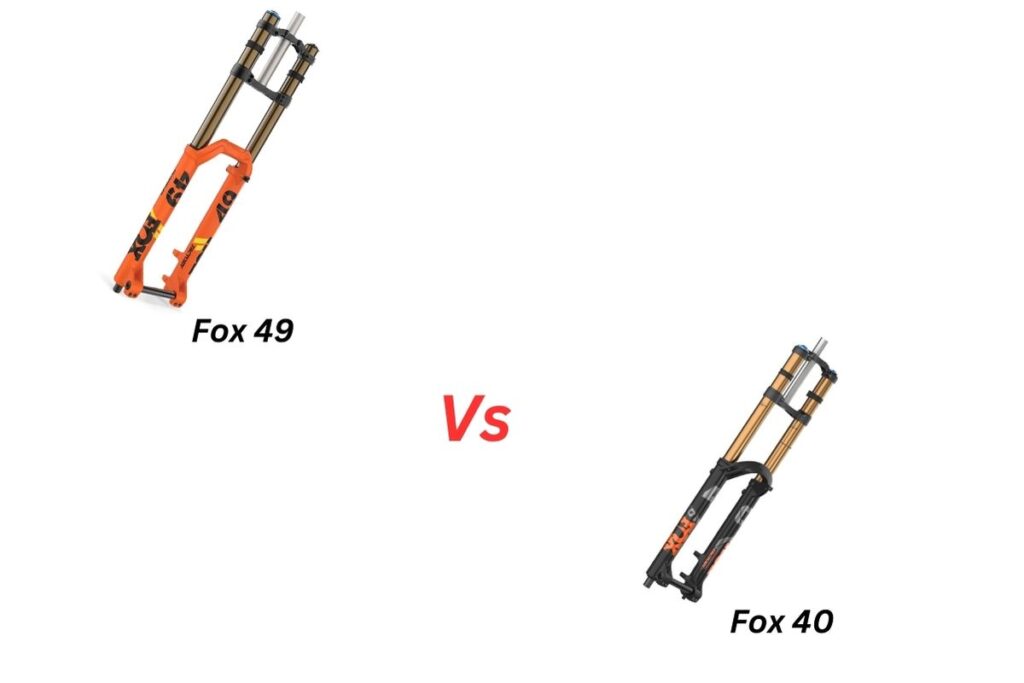
The Fox 49 fork is a high-performance suspension fork designed for aggressive downhill riding. It is built to handle the most demanding terrain and provide riders with superior control and stability. While, the Fox 40 fork is also a well-regarded option in the downhill world, offering a balance of performance and reliability.
Below, we will explore the key features, performance characteristics, adjustability options, and user experiences of both the Fox 49 and Fox 40 forks. By understanding their strengths and weaknesses, you’ll be better equipped to choose the fork that suits your riding style and preferences.
Fox 49
Fox 49 fork is a suspension fork designed for mountain biking. It has a travel of 180 mm, a FIT GRIP2 damper, and a FLOAT EVOL air spring. It offers four-way adjustability, allowing riders to fine-tune the compression and rebound settings. It also features a Kashima Coat, which reduces friction and enhances durability.
The Fox 49 fork is compatible with 29-inch wheels and has a 20×110 mm axle. The fork weighs 2.98 kg and has a steerer tube diameter of 1.125 inches. The Fox 49 fork is a high-performance fork that can handle rough terrain and aggressive riding styles.
Fox 40
The Fox 40 fork is a high-performance suspension fork designed for downhill mountain biking. It features a Grip2 damper with Variable Valve Control (VVC), an updated EVOL air spring, and a floating axle system that improves chassis alignment and reduces friction.
This Fork has a travel of 203mm and a rake of 48mm. It is compatible with 27.5-inch wheels and 20x110mm axles. The fork has a matte black finish with Kashima-coated stanchions for durability and smoothness.
Fox 49 vs 40: Quick Comparison
| Feature | Fox 49 | Fox 40 |
|---|---|---|
| Suspension Travel | 203mm (8 inches) | 203mm (8 inches) |
| Stanchion Tube Diameter | 40mm | 40mm |
| Adjustability | High-speed & low-speed compression damping, rebound damping | High-speed & low-speed compression damping, rebound damping |
| Terrain Suitability | Downhill, aggressive riding, steep descents, rock gardens, jumps | Downhill, aggressive riding, steep descents, rock gardens, jumps |
| Weight | Slightly heavier | Relatively lighter |
Performance
Both the Fox 49 and Fox 40 forks excel in terms of performance, offering exceptional capabilities for downhill riding. They provide plush and controlled suspension travel, allowing riders to tackle rough and technical terrain with confidence.
The large 203mm (8 inches) of travel in both forks ensures ample cushioning for absorbing big hits and maintaining traction on challenging downhill sections.
In terms of stiffness, both forks feature a robust 40mm stanchion tube diameter, providing excellent rigidity and precise handling. The increased stiffness minimizes flex and enhances the forks’ responsiveness, enabling riders to navigate through demanding trails with accuracy.
Adjustability and Tuning
When it comes to adjustability, the Fox 49 and Fox 40 forks offer a range of tuning options to suit individual preferences and riding styles.
Both forks incorporate high-speed and low-speed compression damping adjustments, allowing riders to fine-tune the forks’ responsiveness and control over different types of terrain.
Additionally, adjustable rebound damping enables precise control over the forks’ return speed, optimizing traction and ride quality.
Read Also: Ext Storia V3 vs. Push Elevensix: Compared
Terrain Suitability
Both the Fox 49 and Fox 40 forks are designed specifically for downhill riding, making them suitable for aggressive descents and challenging trail conditions. They excel in providing stability, control, and plush suspension to tackle steep descents, rock gardens, and jumps.
Though, it’s worth noting that the suitability of each fork may vary depending on the specific demands of your preferred terrain and riding style. Consider factors such as the severity of the trails, the presence of technical features, and your personal riding preferences when making a decision.
Read Also: Magura MT7 vs. MT8: Compared
Weight and Stiffness
In terms of weight, both forks are built to withstand the rigors of downhill riding and offer robust construction. However, the Fox 49 fork tends to be slightly heavier due to its larger size and additional features.
It’s important to consider the trade-off between weight and performance when choosing between the two forks, as the Fox 49’s increased weight may provide added stability and durability, while the Fox 40’s relatively lighter weight may offer more agility and maneuverability.
When it comes to stiffness, both forks feature the same 40mm stanchion tube diameter, providing excellent rigidity for precise handling and control. The increased stiffness minimizes flex, allowing riders to maintain control and navigate challenging terrain with confidence.
Read Also: Shimano RT66 vs. RT86: Compared
User Reviews and Recommendations
User reviews and recommendations can offer valuable insights into the real-world experiences of riders who have used the Fox 49 and Fox 40 forks. Take the time to research and read user feedback to gather additional perspectives on the forks’ performance, durability, and overall satisfaction. While individual experiences may vary, these reviews can provide useful guidance and help you make an informed decision.
Conclusion
When making a decision between the two forks, it’s essential to consider your specific riding style, terrain preferences, and personal preferences for adjustability and weight. Additionally, consulting user reviews and seeking expert advice can provide further insights to guide your choice.
Ultimately, both the Fox 49 and Fox 40 forks are trusted and respected options in the downhill mountain biking community. With their exceptional performance characteristics, they are capable of elevating your riding experience and taking your skills to new heights. Choose the fork that aligns with your needs and preferences, and get ready to conquer the trails with confidence.
